| Author |
Message |
Kirk Lee Spencer

|
 Posted: Mon 15 Oct, 2007 9:04 am Post subject: Sword Bayonets and Vestigial Swords Posted: Mon 15 Oct, 2007 9:04 am Post subject: Sword Bayonets and Vestigial Swords |
 |
|
I ran across a replica of a sword bayonet in an Atlanta Cutlery catalogue. I was tempted to buy one, but wanted to do some research. In the course of my research, I found an original sword bayonete that was $20 cheaper than the replica. It is a British pattern 1858 Enfield Sword Bayonet.
Overall length is 28 inches.
Blade Length 23 inches.
PoB is 3 inches from guard.
Weight is 1lb. 11oz.
If swords were attached to rifles in their declining days and then these sword bayonets became progressively shorter. Then swords may still be around in vestigial form as knife bayonets. Actually not truly vestigial as, in certain circumstances, they still perform the primary function of a sword.
It would be interesting to here your thoughts on this and if there may be other vestigial forms of swords still in use today?
 Attachment: 98.16 KB Attachment: 98.16 KB
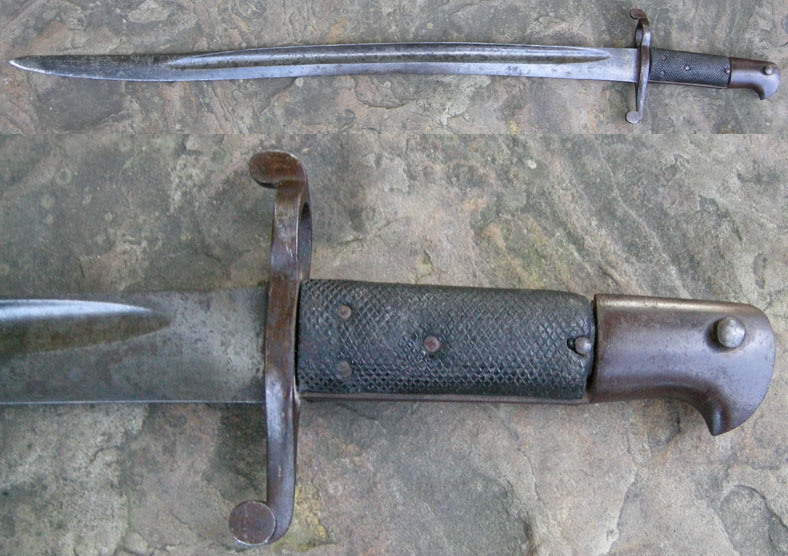
 Attachment: 98.91 KB Attachment: 98.91 KB
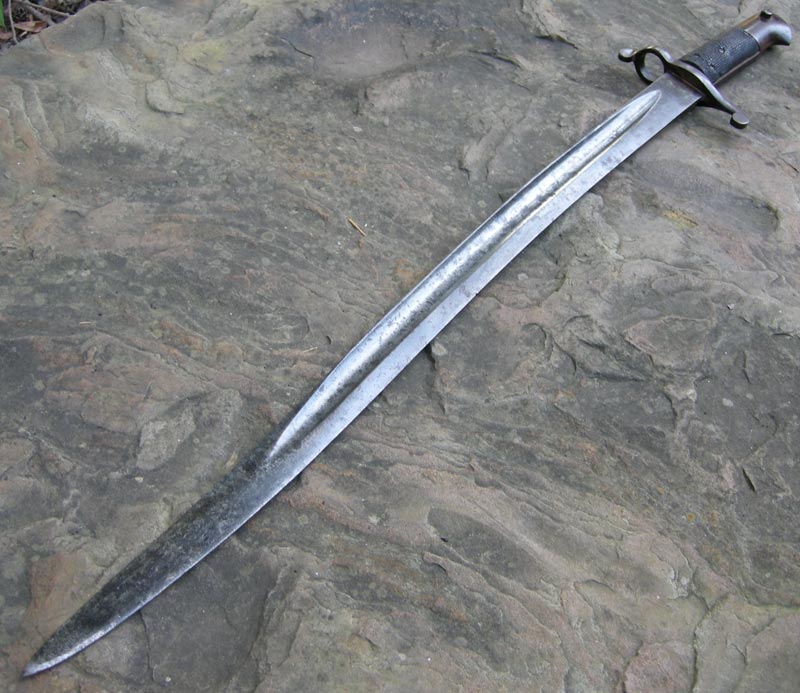
 Attachment: 98.83 KB Attachment: 98.83 KB
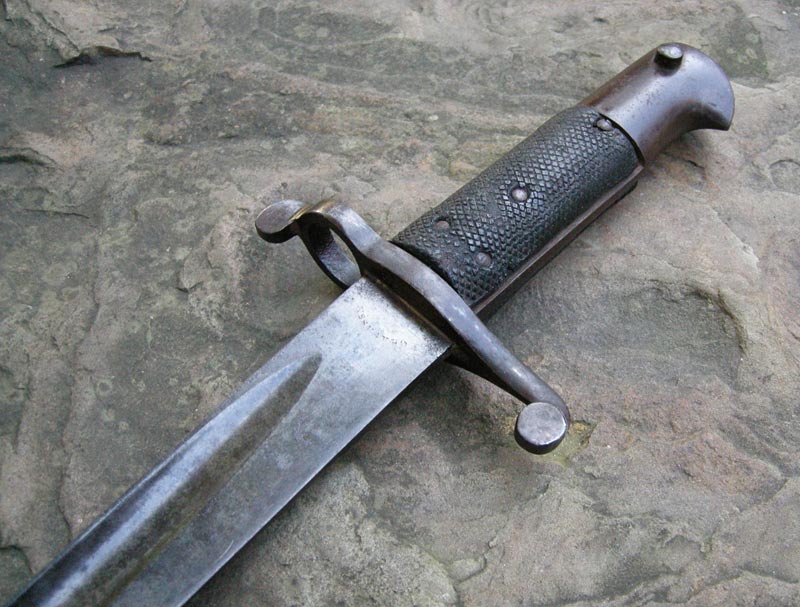
 Attachment: 98.29 KB Attachment: 98.29 KB
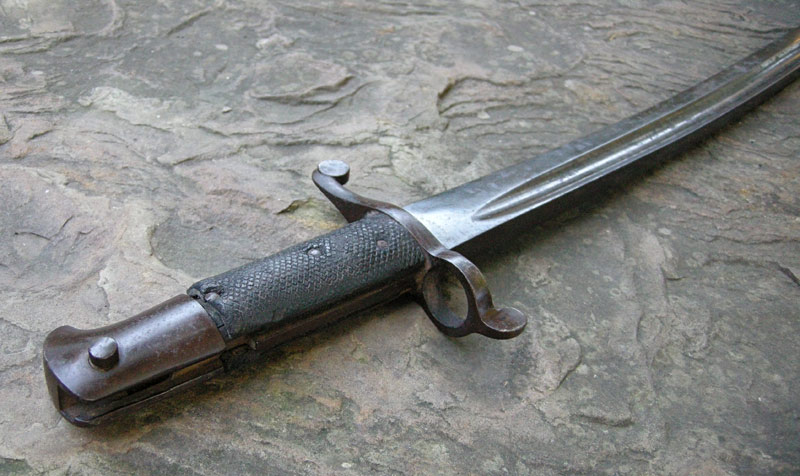
Two swords
Lit in Eden’s flame
One of iron and one of ink
To place within a bloody hand
One of God or one of man
Our souls to one of
Two eternities
|
|
  |
 |
Gordon Frye

|
 Posted: Mon 15 Oct, 2007 7:01 pm Post subject: Posted: Mon 15 Oct, 2007 7:01 pm Post subject: |
 |
|
Kirk;
The primary reason for the issue of sword bayonets was that with shorter rifles (such as the Baker, then the two-band Enfield Rifle Muskets, and finally with such "short rifles" as the SMLE and the US M1903, there was the perceived need for the "reach" of the shorter weapon to be the same as that of the full-length muskets or the rifles they replaced. In other words, the two-band Enfield when mounted with the sword-bayonet such as you purchased will have the same overall length as the Pattern 1853 musket with the triangular socket bayonet mounted on it. Likewise the SMLE with it's Pattern 1907 Bayonet was the same length as the "Long Lee" with bayonet, and the M1903 Rifle with it's bayonet was the same length as the Krag with bayonet.
BTW, in British regiments where they had been designated "Rifles", the commands are still "Fix Swords!"
Anyway, interesting sword-bayonet!
Cheers!
Gordon
"After God, we owe our victory to our Horses"
Gonsalo Jimenez de Quesada
http://www.renaissancesoldier.com/
http://historypundit.blogspot.com/
|
|
    |
 |
|
Dan P
Location: Massachusetts, USA Joined: 28 Jun 2007
Posts: 208
|
 Posted: Tue 16 Oct, 2007 8:45 am Post subject: Posted: Tue 16 Oct, 2007 8:45 am Post subject: |
 |
|
| Quote: | | It would be interesting to here your thoughts on this and if there may be other vestigial forms of swords still in use today? |
Its always been my understanding that the sword bayonet and the long socket bayonet were discarded in favor of the much shorter "knife" style when the bayonet charge ceased to be a useful tactic.
Basically a long weapon may have had some advantage when a group of men were charging or defending on a battlefield in a group, but a short, agile weapon is better as an "emergency option" for a single man with a rifle or carbine caught at close quarters. Like how pikemen would fight with their pikes in formation but as soon as things got mixed up they would drop the pikes and draw baselards or whatever. Handguns today pretty much serve a similar purpose to swords a few hundred years ago- not the most effective thing to depend on in a battle, but good as a backup and portable civilian weapon.
|
|
  |
 |
Chris Goerner

|
 Posted: Tue 16 Oct, 2007 2:49 pm Post subject: Posted: Tue 16 Oct, 2007 2:49 pm Post subject: |
 |
|
Kirk,
I have seen bayonets of this type before, and have always wondered why the blade is shaped as it is with the pronounced "dip". Do you know the reason? Did it make the bayonet more effective at parrying an opponent's thrust?
Chris
Sic Semper Tyranus
|
|
  |
 |
|
Jonathan Hopkins
|
 Posted: Tue 16 Oct, 2007 4:10 pm Post subject: Posted: Tue 16 Oct, 2007 4:10 pm Post subject: |
 |
|
This bayonet has a yataghan style blade, which is know for its "dip" or recurved blade. I do not know about the advantages it would give for use as a bayonet, but I would think that putting the balance further up the blade might aid in cutting. Several 19th century sword bayonets make use of the yataghan blade. Here are a few bayonets, one of which (a French M1842 sabre bayonet) has a yataghan blade:
Edited to add that I when I said I thought the yataghan design was suited to cutting, I was referring to a bayonet that is being used alone, not affixed to a rifle.

Last edited by Jonathan Hopkins on Tue 16 Oct, 2007 7:02 pm; edited 1 time in total
|
|
  |
 |
Thomas Watt

|
 Posted: Tue 16 Oct, 2007 6:06 pm Post subject: Posted: Tue 16 Oct, 2007 6:06 pm Post subject: |
 |
|
I've been thinking about this since the first query was posted.
My experience with bayonet training causes me to think of the bayonet as a substitute for a pike, rather than for a sword. I'm not saying that there weren't crossover weapons, just that based on how I was trained to use it, it is basically a pike weapon. During the heyday of bayonet charges, officers and senior non-commissioned officers carried and used swords rather than a rifle and bayonet.
Since I seem to recall a few other vets on being on here, so perhaps others will chime in...
or have I strayed seriously off the topic.?.
Have 11 swords, 2 dirks, half a dozen tomahawks and 2 Jeeps - seem to be a magnet for more of all.
|
|
  |
 |
Gordon Frye

|
 Posted: Tue 16 Oct, 2007 9:38 pm Post subject: Posted: Tue 16 Oct, 2007 9:38 pm Post subject: |
 |
|
| Chris Goerner wrote: |
I have seen bayonets of this type before, and have always wondered why the blade is shaped as it is with the pronounced "dip". Do you know the reason? Did it make the bayonet more effective at parrying an opponent's thrust?
Chris |
Chris, my understanding is that the yataghan-style bayonet was adopted in order to facilitate the loading of the rifles from the muzzle, though it's not absolutely necessary. Nor is it necessary that a yataghan bayonet is for a muzzle loader, of course. But more often than not, the yataghan's are for late-period muzzle-loaders, and their immediate successors.
Cheers,
Gordon
"After God, we owe our victory to our Horses"
Gonsalo Jimenez de Quesada
http://www.renaissancesoldier.com/
http://historypundit.blogspot.com/
|
|
    |
 |
Kirk Lee Spencer

|
 Posted: Wed 17 Oct, 2007 6:40 am Post subject: Posted: Wed 17 Oct, 2007 6:40 am Post subject: |
 |
|
Great comments all around! Thanks guys 
Gordon,
I never thought about the curve facilitating loading at the muzzle... Great point!
To my eye there is a certain beauty to the curve of falcata and yataghan. In hand, the yataghan curve really does feel like it would make a nasty slashing cut, sort of like a curved saber blade... not just in hand but at the end of rifle it also would be devastatating slashing as well as thrusting.
Jonathan,
Thanks for posting the pictures... excellent stuff.
I agree with Thomas about the bayonetted rifle as being more like a pike (attaching your sword to your rifle to make a spear). But that is the very thing that fascinates me about this particular moment in the history of arms. When my grandfather died he left me the well worn bolt action military rifle with a long bayonet he had used in the war. I can remember putting it all together and leaning it against the wall of my bedroom. I was mesmerized by its design and form. And when I would hold it in hand, it seemed to be conveying something that I could appreciate but not understand... not sure why it had such an effect on me. I think now that part of the equation was that in this object the long history of swords, spears and their nemesis, firearms, all came together in a beautiful nexus as one object.
Thanks again for the great comments... 
ks
Two swords
Lit in Eden’s flame
One of iron and one of ink
To place within a bloody hand
One of God or one of man
Our souls to one of
Two eternities
|
|
  |
 |
|
Geoff Wood
|
 Posted: Wed 17 Oct, 2007 7:05 am Post subject: Posted: Wed 17 Oct, 2007 7:05 am Post subject: |
 |
|
| Gordon Frye wrote: | | Chris Goerner wrote: |
I have seen bayonets of this type before, and have always wondered why the blade is shaped as it is with the pronounced "dip". Do you know the reason? Did it make the bayonet more effective at parrying an opponent's thrust?
Chris |
Chris, my understanding is that the yataghan-style bayonet was adopted in order to facilitate the loading of the rifles from the muzzle, though it's not absolutely necessary. Nor is it necessary that a yataghan bayonet is for a muzzle loader, of course. But more often than not, the yataghan's are for late-period muzzle-loaders, and their immediate successors.
Cheers,
Gordon |
That's the best explanation I've heard so far. I'd personally speculated as to whether, if they were long and straight, the bayonet tips would be in view when they were trying to sight for longer range fire, but the loading thing sounds more sensible.
Geoff
|
|
  |
 |
Ed Toton

|
 Posted: Wed 17 Oct, 2007 7:17 am Post subject: Posted: Wed 17 Oct, 2007 7:17 am Post subject: |
 |
|
| Geoff Wood wrote: |
That's the best explanation I've heard so far. I'd personally speculated as to whether, if they were long and straight, the bayonet tips would be in view when they were trying to sight for longer range fire, but the loading thing sounds more sensible.
Geoff |
I agree. I had the thought that perhaps it was to minimize the risk of the tip being struck by the projectile or fragments from the discharge. But this sounds much more sensible. I've been curious as well, since I have one that's been handed down through my family (originally belonging to my great-grandfather in Queen Victoria's army, if I recall correctly):

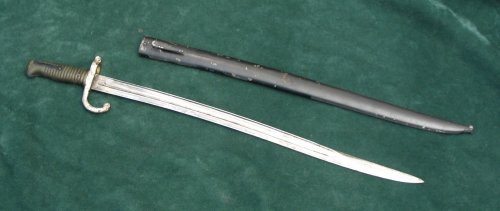
I did some rust-removal on the guard a few years ago (originally it was the same color as the grip), and somewhat regret that now. The patina gives it a lot of character.
The blade is nearly 23" long, so I classify it as more of a sword in my collection, rather than a knife or dagger.
-Ed T. Toton III
ed.toton.org | ModernChivalry.org
My armor photos on facebook
|
|
   |
 |
|
Jonathan Hopkins
|
 Posted: Wed 17 Oct, 2007 9:11 am Post subject: Posted: Wed 17 Oct, 2007 9:11 am Post subject: |
 |
|
Ed,
I think that is a French bayonet for the Chassepot (sp) rifle. I am not sure since I don't have any sources with me at the moment. As far as a timeline of use, it fits between the French M1842 I have pictured, and the two just below it, which are French M1872 epee bayonets for the Gras rifle, so yours would probably be 1860s-ish(?).
Jonathan
PS--I'll try to get you some better info when I get home.
|
|
  |
 |
Chad Arnow
myArmoury Team


|
|
    |
 |
|
Jonathan Hopkins
|
 Posted: Wed 17 Oct, 2007 10:56 am Post subject: Posted: Wed 17 Oct, 2007 10:56 am Post subject: |
 |
|
Thanks, Chad! 
|
|
  |
 |
Thomas Watt

|
 Posted: Wed 17 Oct, 2007 2:05 pm Post subject: Posted: Wed 17 Oct, 2007 2:05 pm Post subject: |
 |
|
| Ed Toton wrote: | | Geoff Wood wrote: |
That's the best explanation I've heard so far. I'd personally speculated as to whether, if they were long and straight, the bayonet tips would be in view when they were trying to sight for longer range fire, but the loading thing sounds more sensible.
Geoff |
I agree. I had the thought that perhaps it was to minimize the risk of the tip being struck by the projectile or fragments from the discharge. But this sounds much more sensible. I've been curious as well, since I have one that's been handed down through my family (originally belonging to my great-grandfather in Queen Victoria's army, if I recall correctly):
|
It might well be both... bullet trajectories on leaving the muzzle are not necessarily straight. A number of 5.56mm round loads perform a significant dip in flight before arcing upwards within the first 5 - 10 meters of their path.
It's also occured to me that it might as easily reflect a common-sense "it needs to be out of the way" approach that had no grounding in actual need, experience, etc. At least I see some of that happening in modern military equipment.
Have 11 swords, 2 dirks, half a dozen tomahawks and 2 Jeeps - seem to be a magnet for more of all.
|
|
  |
 |
|
Jonathan Hopkins
|
 Posted: Wed 17 Oct, 2007 3:10 pm Post subject: Posted: Wed 17 Oct, 2007 3:10 pm Post subject: |
 |
|
Here is a bit on yataghan bladed bayonets from Anthony Carter's World Bayonets 1800 to the Present:
"In France a revolutionary change in bayonet blade design was made which influenced the shape of bayonets throughout the world for the next fifty years. Their brass-hilted Model 1840 sabre bayonet had been introduced with a recurving blade based on the Indo-Persian yataghan, a weapon which had spread to Turkey and the Balkans. The yataghan blade provided a curved cutting edge and a thrusting point in line with the barrel. Initially this bayonet and its derivatives, the Models 1842 and 1842/59, were only issued to elite troops. Britain issued a copy of the M1842 with a ribbed brass hilt to the artillery in 1852, but by 1856 had adopted yataghan-bladed bayonets with steel hilts and chequered black grips. However, in 1866 the French decided to issue their new Chassepot rifleand M1866 sabre bayonet not just to elite troops but to all their infantry. Most of Europe followed with remarkable speed."
|
|
  |
 |
|
Hugh Fuller
|
 Posted: Thu 18 Oct, 2007 12:54 pm Post subject: Posted: Thu 18 Oct, 2007 12:54 pm Post subject: |
 |
|
Just a thought, but the dip might also be there to keep the baynet out of the way of your hand when working the ramrod in a muzzle loader. I am probably way off-base, but that is what first occurred to me when Isaw the question. As to their continuance into breechloading weapons, I would say that this was most likely the result of the well-known military conservatism.
Hugh
Still trying to walk in the Light
Please see 1 John 1:5
|
|
  |
 |
Jack W. Englund

|
 Posted: Sun 11 Nov, 2007 2:11 pm Post subject: Posted: Sun 11 Nov, 2007 2:11 pm Post subject: |
 |
|
| Gordon Frye wrote: | Kirk;
The primary reason for the issue of sword bayonets was that with shorter rifles (such as the Baker,
BTW, in British regiments where they had been designated "Rifles", the commands are still "Fix Swords!"
Anyway, interesting sword-bayonet!
Cheers!
Gordon |
Gorden as usual you are correct. For an excelent look @ Baker Rifle Bayonets see "British Military Flintlock Rifles1740-1840 ( Pg.140-144)
BTW, according to the journals of the 95th Rifles & others, the bayonet was seldom attatched (only when the unit fell in with the"Besses" or were used as reg. assault troops. The gen. opinion was that they were only good for cooking meat & bread over the fire or for digging holes (kind if like our opinin in the US Army 
Jack (aka PUFFER)
|
|
  |
 |
|
|

